- Top
- Culture
- Annual Event
- New Year's dish
New Year's dish Osechi-ryori
Japanese eat New Year's dish Osechi-ryori!?
Osechi-ryori is a major New Year's dish in Japan. To eat it means to get the power of the Toshigami who is a god of the New Year. Osechi-ryori consits of many dishes in the several boxes like bento boxes. It is also like a dinner of five-courses, side dish for alcoholic drink, appetizer, vinegared vegetable, grilled meat or seafood, boiled dish. Each of them has thier own meaning and wish.
The origin of Osechi-ryori is one of the Sekku-ryori in Yayoi period(300BC-250AD). It is a seasonal festival's dish with wishing huge harvest and appreciating nature's bounty. Japanese eat it only on New Year's day before they were aware of that. The origin of Nanakusagayu is also one of the Sekku-ryori.
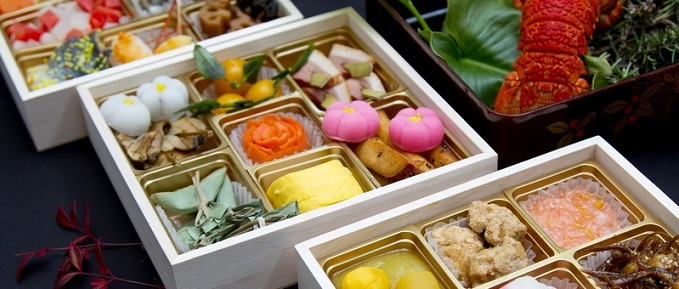
Osechi-ryori is in nest of boxes called Jyubako like bento box tower. Piling up boxes means to accumulate happiness and fortune. Official Osechi-ryori has four-stage though two or three stage one is sold in department stores and grocery stores. Each stages and dishes have a meaning.
Side dish for alcoholic drink called Iwaizakana is in the top stage of Jyubako. Sweet dishes are also packed in this stage because children cannot drink alcoholic beverges. Three dishes called Mitsuzakana are essential to this stage. Three dishes are herring roe, dried sardines and black soy-beans in Kanto area including Tokyo. In Kansai area including Osaka and Kyoto, three dishes are herring roe, dried sardines and tenderized burdock roots.
Herring roe called Kazunoko and tenderized burdock roots called Tataki-Gobo are eaten to pray for being blessed with children and prosperity of descendants. Dried sardines called Tazukuri is eaten to pray for huge harvest because sardines were manures of farms in the past.. Black soy-beans called Kuro-mame is for perfect job and health because "mame" means to be diligent in Japanese.
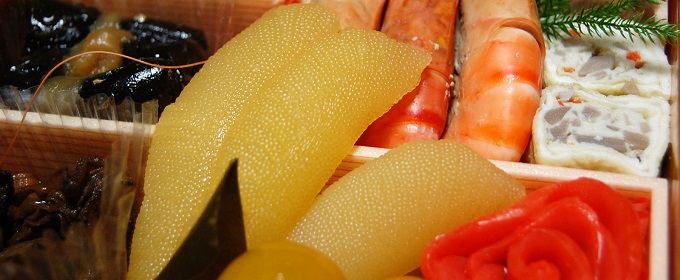
Appetizers called Kuchitori and vinegared vegetable called Sunomono are in the second stage of Jyubako. Datemaki which is one of the Kuchitori is eaten for praying to be elegance and smart. It is rolled omlet made from eggs. Kurikinton made from mashed sweet potatoes and sweetened chestnuts is eaten as a lucky charm for making fortune. Kohaku-namasu which is one of the Sunomono dishes made from vinegared sliced radish and carrot. It is eaten for praying to spread one's roots like them.
Grilled meat or seafood called Yakimono is in the third stage of Jyubako. It is popular that only seafood is in it in the past, but is popular that seafood and meat is in there nowadays. Japanese amberjack is eaten to succeed in the life beause this fish is called by different names as they grow older. A shrimp is also eaten to live long till one's body becomes bent like it.
Boiled dish called Nimono is the fourth stage of Jyubako. It consits various vegetable and mushroom falvored with soysauce, sake, sugar and dashi soup. A lotus roots is eaten to see outlook for the future because of its hole. Corms of Colocasia esculenta and arrowhead are eaten to pray for being blessed with children because they have many young one.
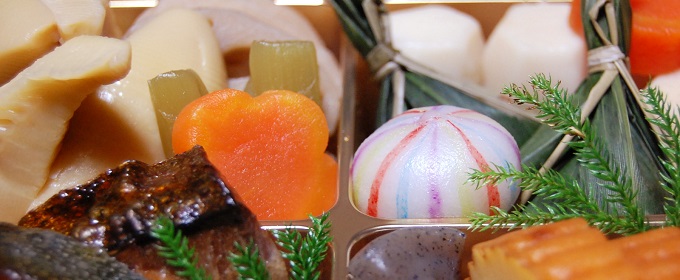
However, some people replace the third stage with the fourth stage, and replace above some dishes with one's favorite dishes, marinade, roast beef, sushi and more. Most osechi-ryori sold in department stores or grocery stores has also two or three stage, and replaces something with thier specialty sometimes.
If you travel Japan in the New Year days, you can experience Japanese culture through Osechi-ryori. Note that many shops, restaurants and department stores close in the first three days of the year.
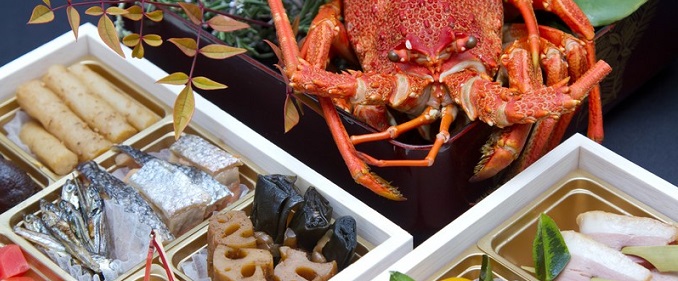
 Hatsuhinode
Hatsuhinode Osechi ryori
Osechi ryori Dezomeshiki
Dezomeshiki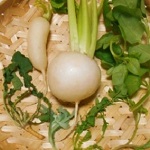 Nanakusa-gayu
Nanakusa-gayu